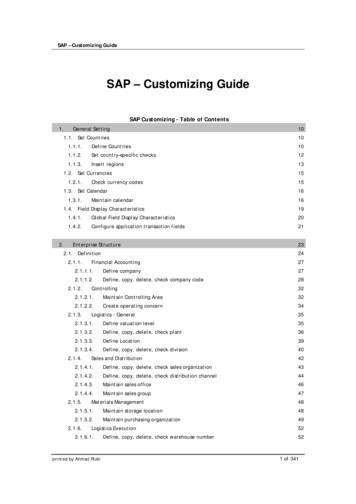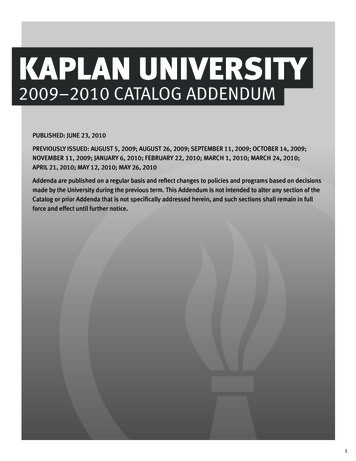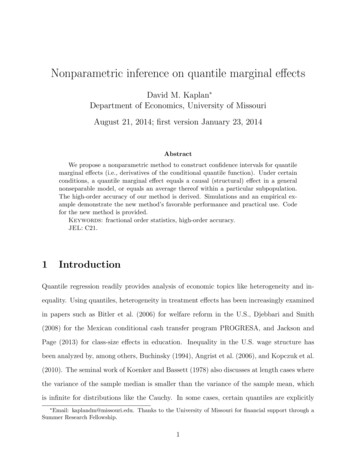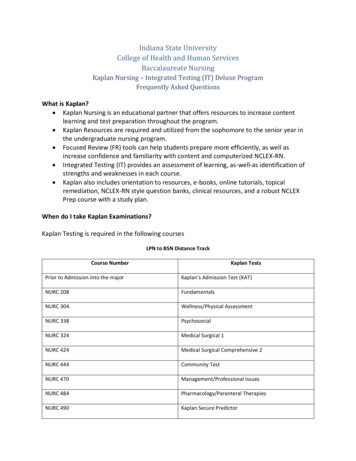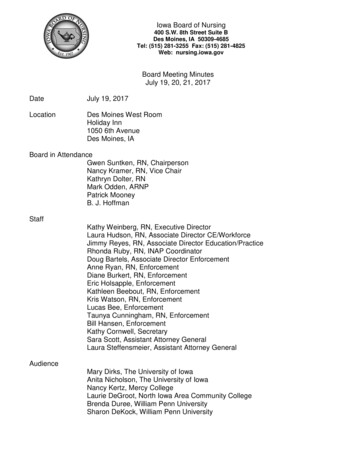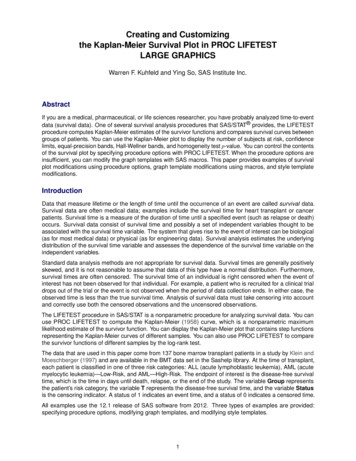
Transcription
Creating and Customizingthe Kaplan-Meier Survival Plot in PROC LIFETESTLARGE GRAPHICSWarren F. Kuhfeld and Ying So, SAS Institute Inc.AbstractIf you are a medical, pharmaceutical, or life sciences researcher, you have probably analyzed time-to-eventdata (survival data). One of several survival analysis procedures that SAS/STAT provides, the LIFETESTprocedure computes Kaplan-Meier estimates of the survivor functions and compares survival curves betweengroups of patients. You can use the Kaplan-Meier plot to display the number of subjects at risk, confidencelimits, equal-precision bands, Hall-Wellner bands, and homogeneity test p-value. You can control the contentsof the survival plot by specifying procedure options with PROC LIFETEST. When the procedure options areinsufficient, you can modify the graph templates with SAS macros. This paper provides examples of survivalplot modifications using procedure options, graph template modifications using macros, and style templatemodifications.IntroductionData that measure lifetime or the length of time until the occurrence of an event are called survival data.Survival data are often medical data; examples include the survival time for heart transplant or cancerpatients. Survival time is a measure of the duration of time until a specified event (such as relapse or death)occurs. Survival data consist of survival time and possibly a set of independent variables thought to beassociated with the survival time variable. The system that gives rise to the event of interest can be biological(as for most medical data) or physical (as for engineering data). Survival analysis estimates the underlyingdistribution of the survival time variable and assesses the dependence of the survival time variable on theindependent variables.Standard data analysis methods are not appropriate for survival data. Survival times are generally positivelyskewed, and it is not reasonable to assume that data of this type have a normal distribution. Furthermore,survival times are often censored. The survival time of an individual is right censored when the event ofinterest has not been observed for that individual. For example, a patient who is recruited for a clinical trialdrops out of the trial or the event is not observed when the period of data collection ends. In either case, theobserved time is less than the true survival time. Analysis of survival data must take censoring into accountand correctly use both the censored observations and the uncensored observations.The LIFETEST procedure in SAS/STAT is a nonparametric procedure for analyzing survival data. You canuse PROC LIFETEST to compute the Kaplan-Meier (1958) curve, which is a nonparametric maximumlikelihood estimate of the survivor function. You can display the Kaplan-Meier plot that contains step functionsrepresenting the Kaplan-Meier curves of different samples. You can also use PROC LIFETEST to comparethe survivor functions of different samples by the log-rank test.The data that are used in this paper come from 137 bone marrow transplant patients in a study by Klein andMoeschberger (1997) and are available in the BMT data set in the Sashelp library. At the time of transplant,each patient is classified in one of three risk categories: ALL (acute lymphoblastic leukemia), AML (acutemyelocytic leukemia)—Low-Risk, and AML—High-Risk. The endpoint of interest is the disease-free survivaltime, which is the time in days until death, relapse, or the end of the study. The variable Group representsthe patient’s risk category, the variable T represents the disease-free survival time, and the variable Statusis the censoring indicator. A status of 1 indicates an event time, and a status of 0 indicates a censored time.All examples use the 12.1 release of SAS software from 2012. Three types of examples are provided:specifying procedure options, modifying graph templates, and modifying style templates.1
Controlling the Survival Plot by Specifying Procedure OptionsThis section provides a series of examples that use ODS Graphics and the PLOTS option in the PROCLIFETEST statement to control the appearance of the survival plot. You can use the following statements toenable ODS Graphics and run PROC LIFETEST:ods graphics on;ods select survivalplot(persist) failureplot(persist);proc lifetest data sashelp.BMT;time T * Status(0);strata Group;run;The results are displayed in Figure 1. ODS Graphics is enabled for this step and all subsequent steps untilODS Graphics is disabled. ODS Graphics remains enabled throughout the examples in this paper. TheODS SELECT statement persistently selects just the survival and failure time plot for this and subsequentsteps. Each analysis produces only one of these two plots. You specify in the TIME statement that thedisease-free survival time is recorded in the variable T. You can further specify that the variable Statusindicates censoring and 0 indicates a censored time. Separate survivor functions are compared for eachof the groups in the Group variable, which you specify in the STRATA statement. The graph in Figure 1consists of three step functions, one for each of the three groups of patients. The graph shows that patientsin the AML—Low-Risk group have longer disease-free survival than patients in the ALL and AML—High-Riskgroups.Figure 1 Default Kaplan-Meier Plot2
The PLOTS option enables you to control some details of the graphs. You can use it to request nondefaultgraphs and specify options for all graphs. For example, you can use the STRATA INDIVIDUAL option torequest individual survival plots. By default, the STRATA OVERLAY option produces the graph of overlaidstep functions displayed in Figure 1. You can run the same analysis but request the results in three separategraphs, one per patient group, as follows:proc lifetest data sashelp.BMT plots survival(strata individual);time T * Status(0);strata Group;run;The first of the three survival plots is displayed in Figure 2. In the interest of space, the other graphs are notdisplayed.Figure 2 One of Three Individual Plots3
You can use the STRATA PANEL option as follows to display the results in separate panels of a singlegraphical display:proc lifetest data sashelp.BMT plots survival(strata panel);time T * Status(0);strata Group;run;The results are displayed in Figure 3.Figure 3 Individual Plots Displayed in a Panel4
The rest of this paper discusses overlaid plots such as the one displayed in Figure 1. You can use thefollowing statements to add Hall-Wellner confidence bands (Hall and Wellner 1980) to Figure 1 and displaythe p-value from a test that the strata are homogeneous:proc lifetest data sashelp.BMT plots survival(cb hw test);time T * Status(0);strata Group;run;The results are displayed in Figure 4. The Hall-Wellner confidence bands extend to the last event. The smallp-value supports rejecting the hypothesis that the groups are homogeneous.Figure 4 Confidence Bands and Homogeneity Test5
You can add the at-risk table as follows:proc lifetest data sashelp.BMT plots survival(cb hw test atrisk);time T * Status(0);strata Group;run;The results are displayed in Figure 5. By default, the at-risk table is displayed inside the body of the graph.For these data, the default survival times are 0, 1000, 2000, and 3000. You will see how to specify othervalues in subsequent examples. This table shows the number of patients who are at risk for each group foreach of the different times.Figure 5 At-Risk Table Inside the Plot6
The group labels for the at-risk table are group numbers, and these numbers appear in the legend. Numbersare used rather than the actual labels because the length of the longest label (13) is greater than the defaultset by the maximum label length option (MAXLEN 12). You can display labels rather than the group numbersby specifying a MAXLEN value equal to the maximum group label length as follows:proc lifetest data sashelp.BMT plots survival(cb hw test atrisk(maxlen 13));time T * Status(0);strata Group;run;The results are displayed in Figure 6. The legend entries and the order of the rows in the at-risk tablecorrespond to the sort order of the values of the Group variable.Figure 6 At-Risk Table with Labels7
You can change the order by first mapping each value to a new value in the desired order, and then runningthe analysis by using a FORMAT statement to provide the original values. The following steps illustrate:proc format;invalue bmtnum 'ALL' 1valuebmtfmt 1 'ALL'run;'AML-Low Risk' 22 'AML-Low Risk''AML-High Risk' 3;3 'AML-High Risk';data BMT(drop g);set sashelp.BMT(rename (group g));Group input(g, bmtnum.);run;proc lifetest data BMT plots survival(cl test atrisk(maxlen 13));time T * Status(0);strata Group / order internal;format group bmtfmt.;run;The PROC FORMAT step has two statements. The INVALUE statement creates an informat that maps thevalues of the original Group variable into integers that have the right order. The VALUE statement creates aformat that maps the integers back to the original values. The informat is used in the DATA step to create anew integer Group variable. You specify the ORDER INTERNAL option in the STRATA statement of PROCLIFETEST step to sort the Group values based on internal order (the order specified by the integers, whichare the internal unformatted values). The FORMAT statement is used to assign the BMTFMT format to theGroup variable so that the actual risk groups are displayed in the analysis. This example also illustratesthe use of the CL option, which displays pointwise confidence limits for the survival curve (instead of theHall-Wellner confidence bands). The results are displayed in Figure 7.Figure 7 Controlling Legend Order8
All the discussion up to this point has been about survival plots. You can instead plot failure probabilities byusing the PLOTS SURVIVAL(FAILURE) option as follows:proc lifetest data BMT plots survival(cb hw failure test atrisk(maxlen 13));time T * Status(0);strata Group / order internal;format group bmtfmt.;run;The results are displayed in Figure 8.Figure 8 Failure Plot9
You can use the PLOTS SURVIVAL(NOCENSOR) option to suppress the display of censored observationsas follows:proc lifetest data BMT plots survival(nocensor test atrisk(maxlen 13));time T * Status(0);strata Group / order internal;format group bmtfmt.;run;The results are displayed in Figure 9.Figure 9 Censored Values Not Displayed10
You can use the PLOTS SURVIVAL(OUTSIDE) option to display the at-risk table outside the body of thegraph. The option OUTSIDE(0.15) reserves 15% of the vertical graph window for the at-risk table. Thisexample illustrates that the PLOTS option has options, options nested within options, and options nestedwithin those nested options. The following step produces the graph in Figure 10:proc lifetest data BMT plots survival(atrisk(outside(0.15)));time T * Status(0);strata Group / order internal;format group bmtfmt.;run;Figure 10 At-Risk Table Outside the Plot11
Because the MAXLEN option was not specified, and because the maximum Group value length is greaterthan 12, integers are used to label the rows of the at-risk table, and those integers appear in the legend inFigure 10. You can specify the MAXLEN 13 option (producing the graph in Figure 11) as follows:proc lifetest data BMT plots survival(atrisk(maxlen 13 outside(0.15)));time T * Status(0);strata Group / order internal;format group bmtfmt.;run;Figure 11 Controlling Legend Order12
The following step explicitly controls the time values at which the at-risk values are displayed by using thePLOTS SURVIVAL(ATRISK 0 TO 3000 BY 500) option:proc lifetest data BMT plots survival(atrisk(maxlen 13 outside(0.15)) 0 to 3000 by 500);time T * Status(0);strata Group / order internal;format group bmtfmt.;run;The results are displayed in Figure 12.Figure 12 Specifying At-Risk Values13
The following step uses the PLOTS SURVIVAL(ATRISK(ATRISKTICK)) option to add tick marks to the axisthat correspond to the at-risk values (250, 1250, 2750) that were specified:proc lifetest data BMT plots survival(atrisk(atrisktick maxlen 13 outside(0.15)) 250 1250 2750);time T * Status(0);strata Group / order internal;format group bmtfmt.;run;The results are displayed in Figure 13.Figure 13 Controlling At-Risk Tick MarksThis section illustrates the basic PLOTS options for controlling the survival plot. If you need to makemodifications that are not shown in this section, see the next section, which shows how to modify the survivalplot by modifying graph templates.Controlling The Survival Plot By Modifying Graph TemplatesEach graph that is created when ODS Graphics is enabled is controlled by a graph template. A graphtemplate is a SAS program, written in the Graph Template Language (GTL), that provides a detailedspecification of the layout and contents of/**/ each graph. You do not need to know anything about GTL touse ODS Graphics, nor do you need to create templates. SAS provides all the templates that you need.However, you can access and modify templates to change the appearance of graphs. Typically, you askODS to display the template of interest, copy it into your editor, modify it, and submit it to SAS to compile.Then, when you run your procedure, it uses the new template. You see the basics of this approach next, butyou do not need to use this approach with the PROC LIFETEST survival plot. The PROC LIFETEST survivalplot is the only plot in SAS for which you have a different alternative available for template modification. SASprovides the survival plot templates in a series of macros and macro variables that are easier to modify thanthe original templates.14
Because it includes the ODS TRACE ON statement, the following step displays in the SAS log the name,label, template, and path for each table and graph:ods trace on;proc lifetest data BMT;time T * Status(0);strata Group;run;The SAS log contains the following information:Output Added:------------Name:SurvivalPlotLabel:Survival SurvivalPath:Lifetest.SurvivalPlot------------You can display the survival plot template by submitting the following step:proc template;source e results of this step (not shown) consist of a 168-line SAS GTL program. This program has two majorparts: one for the single-stratum case and one for the multiple-strata case. Many syntax elements appear inmultiple places, and understanding and modifying this version of the template can be challenging.The modularized version of the survival plot templates is available in the SAS sample library, which isavailable on the Web at t/ex code/121/templft2.html.1 The following step displays the sample:options ls 95;data null ;infile at/ex code/121/templft2.html'device url;retain pre 0;input;if index( infile , ' /pre ') then pre 0;if pre then put infile ;if index( infile , ' pre ') then pre 1;run;In the interest of space, the results of this step are not shown here, but all the code is displayed later. Thesample consists of a single macro definition, %SurvivalTemplateRestore. This macro contains a %GLOBALstatement, 12 %LET statements, and 6 macro definitions, and it ends with a call to the %SurvivalTemplatemacro, which compiles the two survival plot templates and is the first macro defined inside the %SurvivalTemplateRestore macro.2 The %SurvivalTemplateRestore macro provides a way to restore the defaultmacros and macro variables. You should not modify any of the statements while they are inside the%SurvivalTemplateRestore macro. Rather, you should use this macro only to provide and restore all thedefault macros and macro variables. You should modify the individual macros and macro variables outsidethe context of the %SurvivalTemplateRestore macro. This will become clearer as you work through theexamples.1 This sample has been revised and no longer matches the original, which is available from t/ex code/121/templft.html. The revised sample simultaneously modifies two templates,one that is used when the at-risk table is inside the graph and one that is used when it is outside.2 You might wonder why these macros are not simply made available in the SAS autocall library. The autocall library providesmacros that you can run. In this context, you do not need to simply run a macro. You need to copy it, extract parts of it, modify thoseparts, and submit the modified code. That is not convenient with the autocall library.15
The %SurvivalTemplateRestore macro and the macros and macro variables that it provides have the followingproperties: Many options, including most of the options that are specified in multiple places in the templates, areextracted to macro variables. The %SurvivalTemplate macro provides the main body of the two templates, so it is easy to recompilethe templates after making changes. The template s the survival template when the at-risk table is inside the body of the plot, and the l2 provides the survival template when theat-risk table is outside the body of the plot.3 The templates are similar, and a macro %DO loop createsboth versions. The table for p-values is stored in the macro %Entry P. The portion of the templates for the single-stratum case is stored in the macro %SingleStratum. The portion of the templates for the multiple-strata case is stored in the macro %MultipleStrata. The macro %AtRiskLatticeStart begins the lattice that contains the graph and the table when the at-risktable is outside the body of the plot. The macro %AtRiskLatticeEnd ends the lattice that contains the graph and the table when the at-risktable is outside the body of plot.This organization makes it easy to identify the relevant parts of the templates, modify these parts, andrecompile the templates. A small portion of the %SurvivalTemplateRestore macro follows:%macro SurvivalTemplateRestore;%global TitleText0 TitleText1 TitleText2 yOptions xOptions tipstipl groups bandopts gridopts blockopts censored censorstr;%let TitleText0 METHOD " Survival Estimate";%let TitleText1 &titletext0 " for " STRATUMID;%let TitleText2 &titletext0 "s";/* plural: Survival Estimates */%let yOptions label "Survival Probability" shortlabel "Survival"linearopts (viewmin 0 viewmax 1tickvaluelist (0 .2 .4 .6 .8 1.0));%let xOptions shortlabel XNAME offsetmin .05linearopts (viewmax MAXTIME tickvaluelist XTICKVALStickvaluefitpolicy XTICKVALFITPOL);. . .%macro SurvivalTemplate;%macro entry p;%macro SingleStratum;%macro MultipleStrata;%macro AtRiskLatticeStart;%macro nd;%mend;%mend;%mend;%mend;3 The macros do not affect any graph that uses graph templates other than the two that are modified here. In particular, the macrosdo not affect the STRATA PANEL plot that uses the template Stat.Lifetest.Graphics.ProductLimitSurvivalPanel andthe failure plot that uses the template Stat.Lifetest.Graphics.ProductLimitFailure.16
Before you modify anything, you must submit the %SurvivalTemplateRestore macro definition from thesample library to SAS. You can both store the code in a temporary file and submit it to SAS by submitting thefollowing statements:data null ;infile at/ex code/121/templft2.html'device url;file 'junk.junk';retain pre 0;input;if index( infile , ' /pre ') then pre 0;if pre then put infile ;if index( infile , ' pre ') then pre 1;run;%inc 'junk.junk' / nosource;Submitting these statements only defines the %SurvivalTemplateRestore macro. It does not make any of itscomponent macros and macro variables available.You can provide the default macros and macro variables by running the following step:%SurvivalTemplateRestoreRunning this step only defines the default macros and macro variables (or restores them if you havepreviously submitted the %SurvivalTemplateRestore macro). It also runs the %SurvivalTemplate macro andhence replaces any compiled templates that you might have created in the past. You can recompile thetemplates by submitting the following step:%SurvivalTemplateThis macro runs PROC TEMPLATE and uses all the macros and macro variables in the %SurvivalTemplateRestore macro (and any that you modified). The result is two compiled templates that are stored ina special SAS data file called an item store. For more information about SAS item stores, see the section“SAS Item Stores” on page 34. Assuming that you have not modified your ODS path by using an ODS PATHstatement, compiled templates are stored in an item store in the Sasuser library. Files in the Sasuser librarypersist across SAS sessions until they are deleted. When you are done with a modified template, it is wiseto clean up all remnants of it by restoring the default macros and by deleting the modified templates from theSasuser template item store. You can restore the default templates by running the following step to deletethe modified templates:proc template;delete Stat.Lifetest.Graphics.ProductLimitSurvival / store sasuser.templat;delete Stat.Lifetest.Graphics.ProductLimitSurvival2 / store sasuser.templat;run;This step deletes the compiled templates, but it does not change any of the macros or macro variables. Onlythe compiled templates affect the graph when you run PROC LIFETEST.A simple, complete program (except for the definition of the %SurvivalTemplateRestore macro from thesample library) with setup, template modifications to change the title, and cleanup works as follows:%SurvivalTemplateRestore/* Make the macros and macro/* variables available*/*/%let TitleText0 "Kaplan-Meier Plot";/* Change the title.%let TitleText1 &titletext0 " for " STRATUMID;%let TitleText2 &titletext0;*/%SurvivalTemplate*/*//* Compile the templates with/* the new title.17
proc lifetest data BMT/* Perform the analysis and makeplots survival(cb hw test); /* the graph.time T * Status(0);strata Group;format group bmtfmt.;run;*/*/%SurvivalTemplateRestore*/*//* Restore the default macros/* and macro variables.proc template;/* Restore the default templates. */delete Stat.Lifetest.Graphics.ProductLimitSurvival / store sasuser.templat;delete Stat.Lifetest.Graphics.ProductLimitSurvival2 / store sasuser.templat;run;The results are displayed in Figure 14. You can see that the title is now “Kaplan-Meier Plot”. There aremultiple title macro variables because there are two different types of plots defined in the survival plottemplates. The first macro variable, TitleText0, contains the text that is the same for both types of plots. Thesecond macro variable, TitleText1, contains the title for the single-stratum case. The third macro variable,TitleText2, contains the title for the multiple-strata case. Both TitleText1 and TitleText2 use the commontext defined in TitleText0. Both TitleText0 and TitleText2 were changed from their original definition; thedefinition of TitleText1 was copied from the %SurvivalTemplateRestore macro. You have to provide allrelevant %LET statements when you modify TitleText0. In this case it is TitleText0 and TitleText2, but it iseasy to copy all three and then just modify TitleText0.Figure 14 Kaplan-Meier Plot Title Modification18
The following statements modify the default tick value list for the Y axis from the default increment of 0.2 tohave an increment of 0.25 and also change the Y-axis label to “Survival”:%SurvivalTemplateRestore%let yOptions label "Survival"linearopts (viewmin 0 viewmax 1tickvaluelist (0 .25 .5 .75 1));%SurvivalTemplateproc lifetest data BMT plots survival(cb hw test);time T * Status(0);strata Group;format group bmtfmt.;run;The results are displayed in Figure 15.Figure 15 Y-Axis Modification19
The following statements modify the default tick value list for the Y axis so that tick marks start at 0.2:%SurvivalTemplateRestore%let yOptions label "Survival"linearopts (viewmin 0.2 viewmax 1tickvaluelist (0 .2 .4 .6 .8 1.0));%SurvivalTemplateproc lifetest data BMT plots survival(cb hw test);time T * Status(0);strata Group;format group bmtfmt.;run;You need to change only the value of the VIEWMIN option, in this case from 0 to 0.2. The VIEWMIN option controls the smallest value shown on the axis (not the smallest tick value from the tick value list). Youdo not need to modify the tick value list. The results are displayed in Figure 16.Figure 16 Y Axis, First Tick Change20
The next example modifies the contents of the %Entry P macro. The original %Entry P macro definition isas follows:%macro entry p;if (PVALUE .0001)entry TESTNAME " p " eval (PUT(PVALUE, PVALUE6.4));elseentry TESTNAME " p " eval (PUT(PVALUE, PVALUE6.4));endif;%mend;This example directly specifies the test name (replacing the internal name “Logrank” with “Log Rank”) andadds blank spaces around the equal sign.%SurvivalTemplateRestore%macro entry p;if (PVALUE .0001)entry "Log Rank p "eval (PUT(PVALUE, PVALUE6.4));elseentry "Log Rank p " eval (PUT(PVALUE, PVALUE6.4));endif;%mend;%SurvivalTemplateproc lifetest data BMT plots survival(cb hw test);time T * Status(0);strata Group;format group bmtfmt.;run;The results are displayed in Figure 17.Figure 17 Cosmetic Inset Entry Change21
Because this template modification replaces a string that is more appropriately set by PROC LIFETEST, youshould clean up afterward as follows:%SurvivalTemplateRestoreproc template;delete Stat.Lifetest.Graphics.ProductLimitSurvival / store sasuser.templat;delete Stat.Lifetest.Graphics.ProductLimitSurvival2 / store sasuser.templat;run;The macros and macro variables are designed so that most of the time you need to modify only the macrovariables and not the macros. However, you have the full flexibility to modify both. You can modify any of thefollowing macro variables:%let TitleText0 METHOD " Survival Estimate";%let TitleText1 &titletext0 " for " STRATUMID;%let TitleText2 &titletext0 "s";/* plural: Survival Estimates */%let yOptions label "Survival Probability" shortlabel "Survival"linearopts (viewmin 0 viewmax 1tickvaluelist (0 .2 .4 .6 .8 1.0));%let xOptions shortlabel XNAME offsetmin .05linearopts (viewmax MAXTIME tickvaluelist XTICKVALStickvaluefitpolicy XTICKVALFITPOL);%let tips%let tipl rolename ( tip1 ATRISK tip2 EVENT)tiplabel ( tip1 "Number at Risk" tip2 "Observed Events")tip (x y tip1 tip2); tiplabel (y "Survival Probability");%let groups group STRATUM index STRATUMNUM;%let bandopts &groups modelname "Survival";%let gridopts autoalign (TOPRIGHT BOTTOMLEFT TOP BOTTOM)border true BackgroundColor GraphWalls:Color Opaque true;%let blockopts repeatedvalues true display (label values) valuehalign startvaluefitpolicy truncate labelposition leftlabelattrs GRAPHVALUETEXT valueattrs GRAPHDATATEXT(size 7pt)includemissingclass false;%let censored%let censorstr markerattrs (symbol plus); " Censored";These macro variables specify a variety of GTL options. You should consult the SAS/GRAPH: GraphTemplate Language Reference for more details. The macro variables are briefly explained next:TitleText0provides the common text that is used in the title for the single-stratum and multiple-strata cases.METHOD is a dynamic variable that PROC LIFETEST sets. In these examples, the valueof METHOD is “Product-Limit”; the product limit method is also known as the Kaplan-Meier(1958) method.TitleText1provides the text for the single-stratum title (relying on TitleText0).TitleText2provides the text for the multiple-strata title (relying on TitleText0).yOptionsprovides the Y-axis options. The LABEL option provides the axis label. The SHORTLABEL option provides the axis label for small plots when the LABEL label is too long. The LINEAROPTS option is used to specify linear axis options. This and most other axes are linearaxes. Alternatives include log-scale axes. The VIEWMIN 0 and VIEWMAX 1 options ensurethat the axis goes from 0 to 1 even when the actual results have a more restricted range. The22
TICKVALUELIST option provides the tick values. Standard SAS number list abbreviationslike 0 TO 1 BY 0.2 are not valid in the GTL.xOptionsprovides the X-axis options. The LABEL option is not provided, so the axis label comes fromthe column label in the ODS data object. The SHORTLABEL option provides the axis label forsmall plots when the label is too long. The short label comes from a dynamic variable providedby PROC LIFETEST. The OFFSETMIN option ensures that there is extra space betweenthe axis and the minimum tick mark. The LINEAROPTS option is used to specify linear axisoptions. The VIEWMAX option ensures that the axis goes to the value in the MAXTIMEdynamic variable set by PROC LIFETEST. The TICKVALUELIST option provides the tickvalues in a dynamic variable. The TICKVALUEFITPOLICY option provides in a dynamicvariable the approach for handling dense tick marks. Approaches include rotation, staggering,and thinning.tipsprovides options for tooltips for the step plots. Tooltips are text boxes that appear in HTMLoutput when you rest your mouse pointer over part of the plot when the IMAGEMAP ON optionis specified in the ODS GRAPHICS statement. Tooltips are provided for the X- and Y-axiscolumns. Additional columns that are assigned roles (and hence are eligible to use as tooltips)include the at-risk and event columns. These columns are given the tooltip labels “Number atRisk” and “Observed Events”. Unless you are specifically interested in tooltips, you probablydo not need to modify this macro variable.tiplprovides a label for the Y-axis tooltip. Unless you are specifically interested in tooltips, you donot need to modify this macro variable.groupsprovides the name of the data object columns that provide group names
Survival data are often medical data; examples include the survival time for heart transplant or cancer patients. Survival time is a measure of the duration of time until a specified event (such as relapse or death) occurs. Survival data consist of survival time and possibly a set of independent variables thought to be




